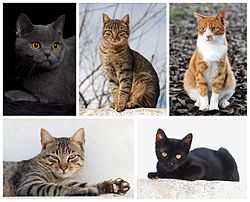Кот
| Кот свойскі | |
 | |
| Клясыфікацыя | |
|---|---|
| Царства | Жывёлы |
| Тып | Хордавыя |
| Падтып | Хрыбетныя |
| Кляса | Сысуны |
| Інфракляса | Пляцэнтарныя |
| Атрад | Драпежныя |
| Падатрад | Коткападобныя |
| Сямейства | Каціныя |
| Падсямейства | Felinae |
| Род | Felis |
| Від | F. catus |
| Бінамінальная намэнклятура | |
| Felis sylvestris catus | |
Кот свойскі (па-лацінску: Félis silvéstris cátus) — свойская жывёліна з атраду драпежных. З заалягічнага пункту гледжаньня, свойскі кот ёсьць сысун сямейства каціных атраду драпежных. Раней свойскага ката нярэдка разглядалі як асобны біялягічны від. З пункту гледжаньня сучаснай біялягічнай сыстэматыкі свойскі кот (лац. Felis silvestris catus) зьяўляецца падвідам ляснога ката (лац. Felis silvestris)[1]. Нягледзячы на тое, што кот можа самастойна паляваць на грызуноў і іншых дробных жывёлаў, ён зьяўляецца сацыяльнай жывёлай[2], якая выкарыстоўвае для зносінаў шырокі дыяпазон гукавых сыгналаў, а таксама фэрамоны і рухі цела[3].
Каты звычайна маюць вагу ад 2,5 да 7 кг. Растуць хутка і ў 6—8 месяцаў дасягаюць плоцевай сьпеласьці. У пэрыяд размнажэньня, зь лютага па верасень, яны надзвычай неспакойныя, імкнуцца зьбегчы з хаты, выдаюць гучныя грудныя гукі, часьцяком і своеасабліва труцца аб розныя прадметы, качаюцца па падлозе. Тэрмін цяжарнасьці складае да 68 сутак. Нашчадзтва звычайна складае ад 1 да 7 кацянятаў, але часьцей за ўсё колькасьцю вар’юецца ад 3 да 6 кацянятаў, якія нараджаюцца сьляпымі й бездапаможнымі, але пачынаюць бачыць ужо на 8—10 содні. У 3—4 тыдні іх можна падкормліваць малаком і іншай лёгкай ежай.
У цяперашні час у сьвеце налічваецца каля 600 млн свйоскіх катоў[4], выведзена каля 256 пародаў, ад даўгашэрсных, як то пэрсыдзкі кот, да пазбаўленых воўны, як то сьфінксы, прызнаных і зарэгістраваных рознымі фэліналягічнымі арганізацыямі. У многіх мясцовасьцях ёсьць клюбы аматараў катоў, якія займаюцца сэлекцыйнай працай, удзельнічаюць у выставах і іншых мерапрыемствах. На працягу 10 тысячаў гадоў каты цэняцца чалавекам, у тым ліку за здольнасьць паляваць на грызуноў і іншых хатніх шкоднікаў[5][6].
Крыніцы
[рэдагаваць | рэдагаваць крыніцу]- ^ Official Lists and Indexes of Names in Zoology, Updated March 2010. (pdf). The International Commission on Zoological Nomenclature
- ^ Sharon L. Crowell-Davis, Terry M. Curtis, Rebecca J. Knowles Social organization in the cat: a modern understanding // Journal of Feline Medicine and Surgery. — 2004. — № 6. — С. 19–28. (анг.)
… while the feral and free-living domestic cat, Felis catus, can survive in the solitary state …, social groups that have internal structure, and in which group members recognize each other and engage in a variety of social behaviors, are formed whenever there are sufficient food resources to support a group … In other words, they are a social species.
- ^ Moelk, Mildred (1944-04). «Vocalizing in the House-Cat; A Phonetic and Functional Study». The American Journal of Psychology (The American Journal of Psychology, Vol. 57, No. 2) 57 (2): 184–205.
- ^ Nicholas Wade. DNA traces 5 matriarchs of 600 million domestic cats. New York Times
- ^ The Evolution of House Cats. Scientific American
- ^ Rob Stein. Tracing Kitty's Genes. The Washington Post
Вонкавыя спасылкі
[рэдагаваць | рэдагаваць крыніцу]- Афіцыйны сайт Сусьветнай фэдэрацыі катоў
- Афіцыйны сайт FIFe (Fédération International Féline)
- Фатаздымкі розных пародаў катоў
Свойская жывёла | |
|---|---|
| Хатнія ўлюбёнцы |
|
| Сысуны сельскагаспадарчага значэньня | |
| Птушкі сельскагаспадарчага значэньня | |
| Казуркі сельскагаспадарчага значэньня |
|
| Выстаўная жывёла |
|
Text is available under the CC BY-SA 4.0 license; additional terms may apply.
Images, videos and audio are available under their respective licenses.
